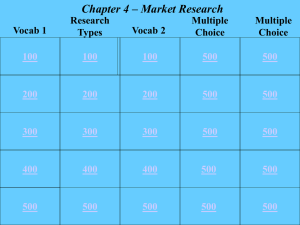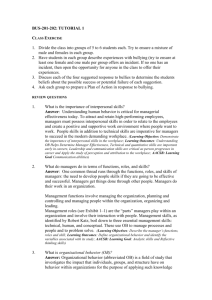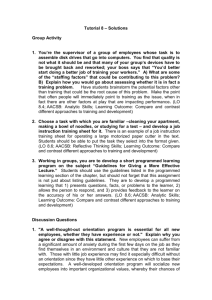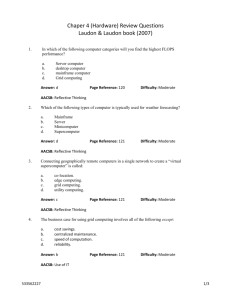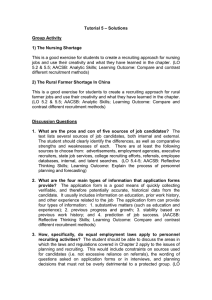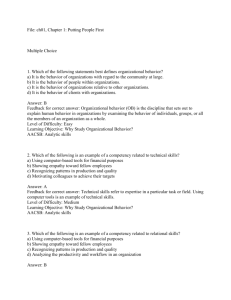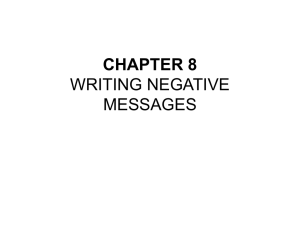4. Which of the following is best defined as a consciously
advertisement
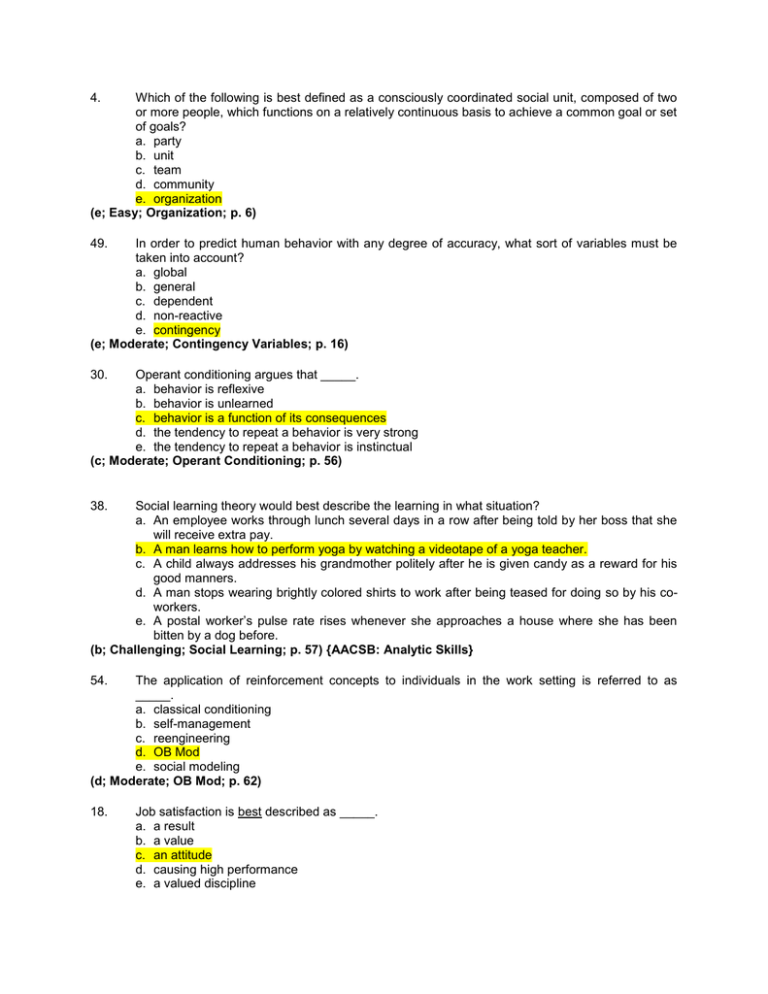
4.
Which of the following is best defined as a consciously coordinated social unit, composed of two
or more people, which functions on a relatively continuous basis to achieve a common goal or set
of goals?
a. party
b. unit
c. team
d. community
e. organization
(e; Easy; Organization; p. 6)
49.
In order to predict human behavior with any degree of accuracy, what sort of variables must be
taken into account?
a. global
b. general
c. dependent
d. non-reactive
e. contingency
(e; Moderate; Contingency Variables; p. 16)
30.
Operant conditioning argues that _____.
a. behavior is reflexive
b. behavior is unlearned
c. behavior is a function of its consequences
d. the tendency to repeat a behavior is very strong
e. the tendency to repeat a behavior is instinctual
(c; Moderate; Operant Conditioning; p. 56)
38.
Social learning theory would best describe the learning in what situation?
a. An employee works through lunch several days in a row after being told by her boss that she
will receive extra pay.
b. A man learns how to perform yoga by watching a videotape of a yoga teacher.
c. A child always addresses his grandmother politely after he is given candy as a reward for his
good manners.
d. A man stops wearing brightly colored shirts to work after being teased for doing so by his coworkers.
e. A postal worker’s pulse rate rises whenever she approaches a house where she has been
bitten by a dog before.
(b; Challenging; Social Learning; p. 57) {AACSB: Analytic Skills}
54.
The application of reinforcement concepts to individuals in the work setting is referred to as
_____.
a. classical conditioning
b. self-management
c. reengineering
d. OB Mod
e. social modeling
(d; Moderate; OB Mod; p. 62)
18.
Job satisfaction is best described as _____.
a. a result
b. a value
c. an attitude
d. causing high performance
e. a valued discipline
(c; Moderate; Job Satisfaction; p. 79)
42.
An important moderator of the satisfaction-turnover relationship is the _____.
a. employee’s level of performance
b. organization’s culture
c. management’s style
d. employee’s values and attitudes
e. employee’s level of workplace deviance
(a; Challenging; Job Satisfaction and Turnover; p. 90)
7.
How would someone who is described as an ESTJ on the Myers-Briggs Type Indicator best be
described?
a. as a visionary
b. as a conceptualizer
c. as an innovator
d. as an organizer
e. as a leader
(d; Moderate; Myers-Briggs Type Indicator Classifications; p. 108) {AACSB: Analytic Skills}
44.
In the U.S., employees in what age group are most likely to leave a job in mid-career to pursue
another that provides more leisure time?
a. 20’s
b. 30’s
c. 40’s
d. 50’s
e. 60’s
(b; Moderate; Xers; pp. 119-120)
57.
What is the measure of the extent to which people in a country accept the fact that power in
institutions and organizations is distributed unequally?
a. caste acceptance
b. collectivism
c. power distance
d. masculinity
e. rigidity
(c; Moderate; Power Distance; p. 124) {AACSB: Multicultural and Diversity}
3.
What are the three classes of factors that influence perception?
a. factors in the setting, factors in the environment, and factors in the motives
b. factors in the perceiver, factors in the target, and factors in the situation
c. factors in the character, factors in knowledge, and factors in experience
d. factors in the personality, factors in the character, and factors in the values
e. factors in the senses, factors in the surroundings, and factors in the lighting
(b; Easy; Factors Influencing Perception; p. 139) {AACSB: Analytic Skills}
14.
What term is used for the extent to which an individual displays different behaviors in different
situations?
a. continuity
b. integrity
c. stability
d. flexibility
e. distinctiveness
(e; Moderate; Distinctiveness; p. 141)
40.
Why is decision making a perceptual issue?
a. Decisions must be made on how to move from the current state of affairs to some desired
state.
b. Middle and lower level managers may have different perceptions on how to solve a problem
than their underlings or top level managers.
c. Decision making is generally by consensus.
d. There may be more than one way to solve a problem.
e. Before a decision is made, a problem must be perceived to exist.
(e; Moderate; Perception and Decision Making; p. 147)
What is the major problem with Maslow’s hierarchy of needs in organizational behavior?
a. It is difficult to apply to the workplace.
b. It is vague as to how a workplace can satisfy higher-order needs.
c. Its terminology tends to alienate those to whom it is applied.
d. It is almost impossible to assess how well an individual has a particular need filled.
e. There is little evidence that needs are structured or operate in the way it describes.
(e; Moderate; Hierarchy of Needs; p. 177-178)
22.
49. According to the goal-setting theory of motivation, highest performance is reached when goals
are set to which level?
a. impossible but inspirational
b. difficult but attainable
c. slightly beyond a person’s actual potential
d. only marginally challenging
e. easily attained
(b; Moderate; Goal-Setting Theory; p. 185)
58.
Which of the following is an example of an MBO objective?
a. Decrease payroll costs by 6%.
b. Modernize outdated equipment.
c. Train employees to use new invoicing software.
d. Improve customer service.
e. Increase employee satisfaction.
(a; Moderate; Management by Objectives; p. 188) {AACSB: Analytic Skills}
17.
What term is used for a participative process that uses the entire capacity of employees and is
designed to encourage increased commitment to the organization’s success?
a. MBO
b. employee involvement
c. reengineering
d. OB Mod
e. job sharing
(b; Moderate; Employee Involvement; p. 225)
23.
Research shows that works councils tend to be ineffective for which of the following reasons?
a. Members of works council tend to side with management when making decisions for fear of
being punished.
b. Works councils represent the wishes of employees that are often at odds with the best
direction of an organization.
c. Works councils are dominated by management and their input has little impact on employees
or the organization.
d. Works councils insert an extra element into decision making which slows the response of an
organization to changing conditions.
e. Members of works councils are in general not qualified to make large decisions concerning the
direction of an organization.
(c; Moderate; Work Councils; p. 226) {AACSB: Analytic Skills}
37.
What is the term used for a pay plan where pay levels are based on how many skills employees
have or how many jobs they can do?
a. a variable pay plan
b. flexible pay
c. competency-based pay
d. gainsharing
e. ISOP
(c; Moderate; Skill-Based Pay; p. 231)
5.
Erin works on a software help desk. After being yelled at by a customer about the state of her
company’s software, she becomes angry, and has to take a short break to calm down. What
makes her anger an emotion, rather than a mood?
a. It is a simple, unambiguous feeling.
b. It interferes with her capacity to work effectively.
c. It has a contextual stimulus.
d. It can be controlled given some time.
e. It cannot be controlled when it is elicited.
(c; Moderate; Emotions; p. 251) {AACSB: Analytic Skills}
25.
Gerardo believes that every time he picks up a penny he is blessed with good fortune, since the
last time he picked up a penny he had a lottery win, and the time before that he got a big bonus at
work. Gerardo’s perception is likely a product of a(n) _____.
a. conjunction error
b. fundamental attribution error
c. ultimate attribution error
d. self-serving bias
e. illusory correlation
(e; Moderate; Illusory Correlation; p. 256) {AACSB: Analytic Skills}
40.
Gina and Hanna are teachers. Gina dislikes her students, but pretends she likes them by making
sure she acts in a friendly manner toward them. Hanna also dislikes her students, but is trying to
change the way she feels about them. Which of these teachers is most likely to feel the most
stress from their actions and why?
a. Gina, since she has to feign genuine emotion
b. Gina, since her deep emotions conflict with what her job requires
c. Hanna, since she will probably display her true feelings before she changes her deep
emotions
d. Hanna, since it is very difficult to change displayed emotion
e. Their actions are unlikely to cause stress.
(a; Challenging; Surface Acting and Deep Acting; p. 262) {AACSB: Analytic Skills}
25.
Which of the following is true of role identity?
a. Role perception creates the attitudes and actual behaviors consistent with a role.
b. People have the ability to shift roles rapidly when the situation requires change.
c. There is considerable inertia in role identity after roles are changed.
d. Everyone is required to play one specific role in every situation.
e. No two people ever agree on what constitutes a role.
(b; Moderate; Role Identity; p. 290)
42.
A group is most likely to tolerate deviation from a group’s conformity norms by which of the
following individuals?
a. a high status individual who does not care about the social rewards the group provides
b. a high status individual who is tightly integrated into the group’s social structure
c. a low status individual who has only recently entered the group
d. a low status individual who strongly wishes to integrate within the group
e. a low status individual who is not well regarded by the rest of the group
(a; Moderate; Status; p. 298) {AACSB: Analytic Skills}
57.
What result can groupshift have on the decisions a group makes?
a. They are made by groups rather than individuals.
b. They are generally riskier.F
c. They are made more quickly.
d. They are less effective.
e. They are objectively incorrect.
(b; Moderate; Groupshift; p. 304)
18.
To provide teams with adequate resources, a company must supply which of the following?
a. proper equipment
b. adequate staffing
c. encouragement
d. all the above
e. none of the above
(d; Moderate; Adequate Resources; p. 328) {AACSB: Analytic Skills}
33.
On her work team, Michelle develops detailed tasks lists and work flow charts to help her team
members understand the steps involved in each project. She also maintains the project calendar
and receives periodic updates from each team member to ensure that projects are progressing
on schedule. Which role does Michelle most likely fill on her team?
a. assessor
b. organizer
c. maintainer
d. creator
e. promoter
(b; Challenging; Key Roles of Teams; p. 332) {AACSB: Analytic Skills}
46.
Your company is considering implementing work teams in your Vietnam facility. You should find
this relatively easy because those employees will have strong _____ values.
a. acculturation
b. collectivist
c. creative
d. cultural
e. capitalistic
(b; Moderate; Collectivist Societies; p. 337) {AACSB: Reflective Thinking} {AACSB: Multicultural
and Diversity}
33.
Which of the following types of networks is most likely to promote accuracy?
a. chain
b. direct
c. wheel
d. all-channel
e. circle
(a; Moderate; Chain Network; p. 359) {AACSB: Communication}
61.
Jake tells his boss only what he believes the boss wants to hear. Jake is engaging in
_____.
a. filtering
b. selective perception
c. communication apprehension
d. emotional block
e. selective selection
(a; Moderate; Filtering; p. 368) {AACSB: Communication} {AACSB: Analytic Skills}
28.
Which model represents the theory that effective group performance depends on the proper
match between a leader’s style and the degree to which the situation gives control to the leader?
a. Leader-Member Exchange Model
b. Fiedler’s Contingency Model
c. Hersey and Blanchard’s Situational Leadership Model
d. Vroom and Yetton’s Leader-Participation Model
e. none of the above
(b; Moderate; Fiedler Contingency Model; p. 392)
48.
The leadership behaviors identified by the path-goal theory are _____.
a. supportive, employee-oriented, laissez-faire, and participative
b. achievement-oriented, supportive, humanistic, and directive
c. participative, achievement-oriented, directive, and supportive
d. directive, participative, supportive, and laissez-faire
e. affective, cognitive, and behavioral
(c; Challenging; Path-Goal Theory; p. 397) {AACSB: Analytic Skills}
Charisma appears to be most successful when the follower’s task has an ideological component
or when the environment involves ________.
a. a high degree of satisfaction or performance
b. a high degree of stress and uncertainty
c. a low degree of competition or individualism
d. a low degree of complacency or acceptance
e. a low degree of social networking or socialization
(b; Moderate; Charismatic Leadership; p. 416)
12.
26.
_____ are considered to use their charisma in a socially constructive way to serve others.
a. Contingent reward leaders
b. Ethical leaders
c. Idealized influence leaders
d. Transformational leaders
e. Trusted leaders
(b; Challenging; Ethics and Leadership; p. 423) {AACSB: Ethical Reasoning}
26.
Dependency is inversely proportional to _____.
a. the level of an individual’s personal power
b. the number of alternative sources of a particular resource
c. the type of informational analysis conducted in a situation
d. the financial resources required to solve a problem
e. a leader’s influence over policy decisions
(b; Challenging; Dependency; p. 454) {AACSB: Analytic Skills}
45.
_____ occurs when people within organizations use whatever influence they can to taint the facts
to support their goals and interests.
a. Legitimate political behavior
b. Politicking
c. Illegitimate political behavior
d. Sabotage
e. Camouflage
(b; Moderate; Politicking; p. 462)
22.
_____ conflicts are almost always dysfunctional.
a. Task
b. Job
c. Relationship
d. Process
e. Personal
(c; Moderate; Relationship Conflict; p. 486)
43.
Conflict management techniques can _____ conflict.
a. resolve
b. stimulate
c. lead to a higher probability of concurrent
d. both resolve and stimulate
e. none of the above
(d; Easy; Conflict-Management Techniques; p. 492)
51.
The two general approaches to bargaining are known as ________.
a. emotional and rational.
b. affective and reflective
c. distributive and integrative
d. formal and informal.
e. legal and restrictive.
(c; Moderate; Bargaining Strategies; p. 496) {AACSB: Analytic Skills}
18.
Which of the following is a drawback of a narrow span of control? It _____.
a. reduces effectiveness
b. is more efficient
c. encourages overly tight supervision and discourages employee autonomy
d. empowers employees
e. increases participatory decision-making
(c; Moderate; Span of Control; pp. 523-524) {AACSB: Analytic Skills}
57.
_____ refers to how an organization transfers its inputs into outputs.
a. Production
b. Technology
c. Operations
d. Process
e. Effectiveness
(b; Challenging; Technology; p. 536) {AACSB: Use of IT}
25.
How would a participator best absorb information?
a. use computers to read manuals
b. watch others and imitate behaviors
c. copy what others do on computers
d. listen to an audiotape
e. gain hands-on experience
(e; Easy; Learning Styles and Formal Training; p. 594) {AACSB: Analytic Skills}
The evaluation method that focuses the evaluator’s attention on those behaviors that are key to
executing a job effectively is known as_____.
a. forced comparison
b. critical incidents
c. graphic rating scales
d. behaviorally anchored rating scales
e. intellectual competence
(b; Easy; Critical Incidents; p. 598)
33.
14.
_____ is a source of organizational resistance.
a. Structural motion
b. Security
c. Unlimited focus of change
d. Support of established power relationships
e. Threat to resource allocations
(e; Moderate; Sources of Organizational Resistance to Change; p. 623)
29.
The action research process closely resembles _____.
a. political research
b. the scientific method
c. organizational development
d. appreciative inquiry
e. an economic paradigm
(b; Moderate; Action Research; p. 628)
49.
Which of the following is a characteristic of a learning organization? Its employees _____.
a. have standard ways of doing their jobs
b. pursue projects of interest
c. focus on breaking down barriers created by hierarchical levels
d. think in terms of independent relationships
e. have high levels of technical knowledge
(c; Challenging; Learning Organization; p. 635) {AACSB: Analytic Skills}
